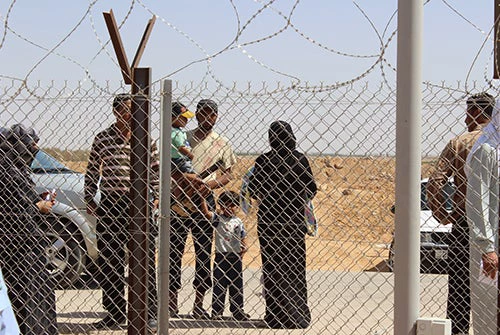 The Syrian war and the subsequent emergence and spread of the Islamic State (ISIS) captured the world’s attention and transformed the Levant in ways one could not have imagined prior to 2011. As the numbers of dead and of refugees and internally displaced kept climbing, and as families were torn apart and neighborhoods were turned into war zones, economies slumped and regional economic ties broke down. The shock of the war has changed the region in profound ways, yet no one has done a systematic evaluation of its economic effect.
The Syrian war and the subsequent emergence and spread of the Islamic State (ISIS) captured the world’s attention and transformed the Levant in ways one could not have imagined prior to 2011. As the numbers of dead and of refugees and internally displaced kept climbing, and as families were torn apart and neighborhoods were turned into war zones, economies slumped and regional economic ties broke down. The shock of the war has changed the region in profound ways, yet no one has done a systematic evaluation of its economic effect.
In a recently released World Bank working paper we attempt to address this issue and quantify both the direct and indirect economic effects of this war on the countries in the greater Levant area—Turkey, Syria, Lebanon, Jordan, Iraq, and Egypt. The direct effect comes from the decline in the size and skills of Syria’s labor force due to loss of life and refugee outflows, infrastructure destruction, the trade embargo on Syria, cost-of-doing-business increases, and a decline in productivity. The indirect effect captures the opportunity cost of foregone trade integration initiatives aimed at improving trade logistics and liberalizing trade in services in the region. The indirect effect is important to consider because the war disrupted the intra-Levant trade, which grew seven-fold between the early and late parts of the 2000s. It put an end to plans for deepening intra-regional trade ties further following the signing of the “Levant Quartet” agreement in 2010. The benefits of deep trade integration reforms were expected to be sizable, reflecting significant economic complementarities, as shown in a recent World Bank study (2014).
We find that, so far, as a result of the war the six economies of the greater Levant taken together have lost close to US$35 billion in output, measured in 2007 prices. In other words, the cumulative economic size of these economies, measured by their Gross Domestic Product, could have been US$35 billion larger had the war not occurred. These aggregate costs of war are equal to the size of Syria’s GDP in 2007!
However, these losses have been unevenly distributed. Those countries most affected by the war, Syria and Iraq, have borne the brunt of the direct economic costs of it, as well as of losing out on what could have been much more formal economic integration: Syria and Iraq have seen per capita income in constant terms declining by 23 percent and 28 percent relative to the levels that could have been achieved if war hadn’t broken out. The costs directly attributed to war, though, are substantial at a 14 percent and 16 percent reduction in per capita GDP for Syria and Iraq, respectively. The trade embargo on Syria has been a major factor behind the direct costs, followed by the decline in the size and skills of its labor force due to the loss of life and exodus of refugees, the destruction of infrastructure and the increase in the cost of doing business in conflict zones.
Other countries in the Levant region have incurred average per capita income losses but not GDP declines due to the direct effects of war. Influxes of refugees into Lebanon, Jordan, and Turkey have boosted consumption, investment and labor supply, and therefore the size of these refugee-receiving economies. But, in all cases, aggregate incomes have increased less than the size of the population, so the war has hurt the standards of living there, with per capita average incomes declining by 11 percent in Lebanon and 1.5 percent in Turkey, Egypt, and Jordan relative to levels that could have achieved had the war been avoided. The opportunity costs of foregone trade integration are larger than the direct costs for Egypt, Jordan, and Turkey.
In Syria, almost every economic sector has been affected negatively, but property-ownership has been particularly badly hit as demand for land has declined steeply, reflecting the drop in demand because of the huge numbers of refugees leaving the country. By contrast, in Lebanon and Turkey, land and business owners have benefited but workers have lost because the arrival of Syrian refugees has increased local demand for goods and services, raising prices, and augmented the labor supply. With quality of services deteriorating and wages falling due to intense competition for jobs, all in all many people have suffered.
The direct effects of war in the region are, sadly, therefore an understatement of the real economic costs of civil war and the spread of ISIS. Because the war has disrupted the growth of strong intra-regional trade and plans for deep trade integration, one must include the foregone benefits of further trade integration in order to provide an accurate assessment of the economic costs of war.
Even so, this still does not factor in the fiscal costs of delivering basic services to refugees in the countries that have received them, nor does it take into consideration the cost of putting-up infrastructure to support them. These costs could be substantial for Lebanon, Jordan, and Turkey, the three countries that have taken the most refugees. The future costs arising from the large numbers of deaths and of replenishing depleted physical and human capital are also likely to be sizable, especially in Syria. From an economic point of view, the magnitude of these shocks have been calculated only up until mid-2014; the eventual size of the economic—including, most importantly, the human—impact will obviously change depending on the course war takes in the Levant.



Join the Conversation